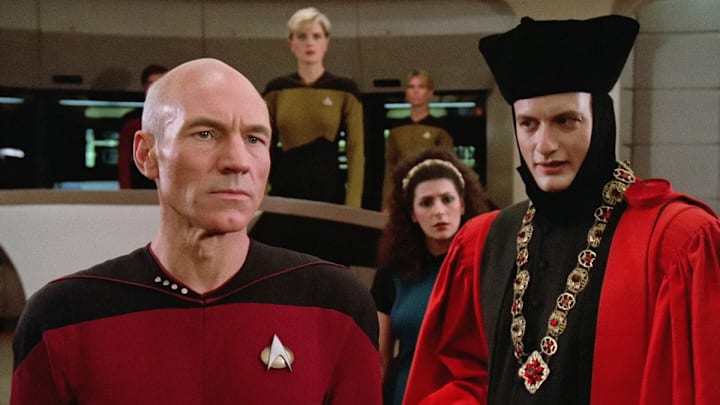One of the most mysterious and iconic characters in Star Trek's lengthy history, Q (John de Lancie) redefines what it means to be a villain in podcasts, movies, and television shows. Since his initial appearance as a cosmic trickster joking with the the USS Enterprise-D's crew back in 1987, Q has developed into a complex enemy that threatens not just Starfleet but also the fundamental tenets of morality and human advancement.
This article examines the traits and cultural changes that make Q's character relevant and essential to both newcomers and devoted fans in the ever-expanding Trek world, as well as how his character has changed with each subsequent Star Trek version.
The trickster puts humanity on trial
Q made his debut in Star Trek: The Next Generation in "Encounter at Farpoint," where he served as both judge and executioner, putting mankind on trial for its violent and arrogant history. In his first act, Q, in judicial robes, became Star Trek's ultimate symbolic enemy, less malevolent than violent, and represented the universe's annoyance with human arrogance.
Q's intellectual superiority and humorous severity made him attractive, but his interest in the potential for human growth was what truly set him apart. Over the course of their frequent encounters, from "Hide and Q" to "Q Who," Q developed into a puzzle that was both a source of anguish and a source of inspiration, pushing Captain Jean-Luc Picard and his crew to enlightenment while enjoying their suffering.
From cosmic jester to reflective mentor
Q changed over time from being purely mischievous to becoming more reflective. We get a glimpse of his vulnerability beneath his bluster in episodes like "Deja Q," where he loses his powers and must live as a mortal. He became more human as a result of this encounter, which made the team and viewers realize that virtual omnipotence does not mean that sorrow is impossible.
Q's development was even more noticeable by Star Trek: Voyager. The inner workings and moral stagnation of the Q Continuum were revealed by episodes such as "Death Wish" and "The Q and the Grey." Throughout these tales, Q transforms from a villain into a philosopher who mulls over the meaning of eternity and muses over mortality, revolt, and rebirth.
Mortality and meaning in Star Trek: Picard
Q's transformation is finished when he returns in Star Trek: Picard. In this latest chapter, Q faces his own mortality rather than humanity's foolishness. His encounters with an older Jean-Luc Picard highlight the shared journey of two beings who were previously at odds with the cosmos by combining mentorship, affection, and sorrow.
Q no longer wants to punish; instead, he wants to find closure for the person he has been pursuing and protecting for decades (Picard), as well as for himself. His empathetic and forgiving farewell reinterprets Q's human difficulties as acts of kindness masquerading as mayhem. He informs Picard, "As I leave, I leave you free," a statement that validates Q's ultimate transformation from god to kindred spirit and transforms judgment into freedom.
Why Q endures
Q's longevity is a reflection of his complex storytelling, not just nostalgia or star power. To test the ethics of mankind in the 1980s, existential restlessness in the 1990s, and the search for meaning in a period of moral exhaustion today, each Star Trek era reimagines Q to appeal to modern viewers.
The franchise's central tenet, that even in the face of limitless knowledge, the ability to develop and become better tomorrow than we are today, is embodied by his unique blend of wit, unpredictable nature, and underlying compassion.
Through Q, Star Trek challenges its own idealism, hubris, and faith in progress, and each time it emerges stronger. He is both a villain and a mirror, showing that the greatest problems we face as a species are the ones we put on ourselves.
For more Star Trek content, visit us on the Redshirts Always Die Facebook and X pages.
